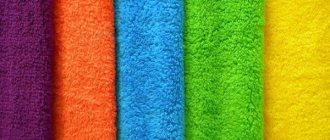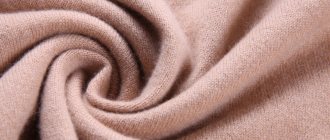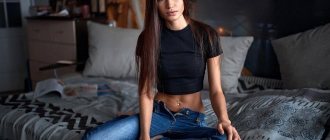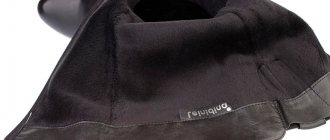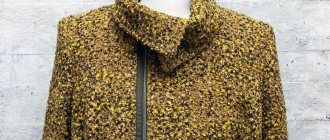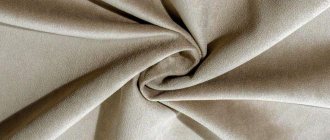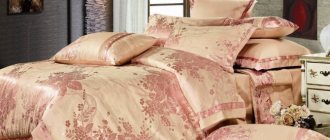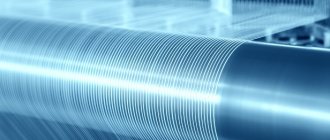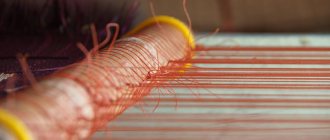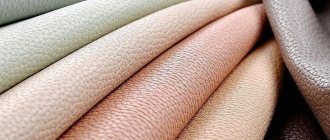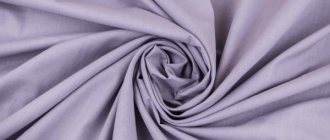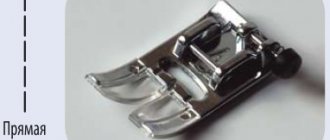Modal is an environmentally friendly and safe fabric, which in its properties is in no way inferior to cotton, and even has a number of additional positive characteristics. It is a soft and plastic fabric obtained artificially based on beech or eucalyptus cellulose.
“The high wet modulus values make modal fabric resistant to shrinkage and stretching. In addition, modal is characterized by softness, smoothness and resistance to fading, as well as high absorption rates. A modal-cotton blend can be used to produce towels, bathrobes and bath mats.” Wikipedia
Composition of modal
Many manufacturers classify the material as both synthetic and natural fabrics. This is due to the special production technology, as well as the fact that the composition of modal is 100% plant raw materials. Today you can find pure fiber, as well as mixed options. Cotton is usually added to them. And the percentage of components is 50 to 50.
Kinds
Based on their composition, there are two main types of modal fabric:
- Clean - made entirely of cellulose fiber. Items made from 100 percent modal are expensive.
- Mixed. As a rule, a combination of modal + cotton is used. The share of the latter can reach up to 50%. This allows you to reduce the price and smooth out some of the disadvantages of natural fiber.
Depending on the weave:
- one-sided - this modal is smooth as silk;
- double-sided - terry, but very soft.
Micromodal is also produced, with threads even thinner than regular modal. Without impurities, such a fabric is quite expensive; it is often used to improve the strength and hygroscopicity of other materials.
History of modal
This fabric first appeared in Japan. Scientists set out to create an artificial material that resembled cotton in its characteristics. And they succeeded in this during an experiment with viscose in 1951. The raw material for modal was eucalyptus tree cellulose.
At first the fabric was called “polinosic”, and after migrating to Austria, it became known as “modal”. Today, mass production has also reached Australia, which has large reserves of eucalyptus.
Currently, modal fabric is used for tailoring. In addition, this material makes quite high-quality and practical tracksuits. Maternity clothes and underwear are also made from the material. Modal is ideal for sewing bed linen, it’s pleasant to sleep on, you won’t sweat or freeze in such a bed, these are extremely high-quality products that will last for many years and provide only positive emotions.
Varieties
The characteristics of the fabric depend on the composition and weaving. According to the first sign they distinguish:
- Pure 100% modal - made only from eucalyptus or beech wood. The material is expensive and is used for sewing fashionable, exclusive clothing.
- Blended - the fiber is most often mixed with cotton. This combination reduces the price of the material, but its properties are preserved. This is the best option for the production of home textiles and linen. When mixed with wool, suit fabrics are obtained. The combination with synthetic threads, like spandex, is interesting: the fabric becomes very elastic, but allows moisture and air to pass through.
Read about a blanket with sleeves for two here.
Recently another variety has appeared - micromodal. The fabric is woven from especially thin threads.
Single and double sided
According to the method of weaving, fabrics are divided into single- and double-sided:
- Single-sided - thin and delicate material with a smooth shiny surface. Its properties are similar to silk, but much lighter and softer.
- Double-sided - the fabric is denser, even rougher. The front side is velvety to the touch, similar to velor. The material retains heat better, but is just as soft.
Advantages of modal fabric
The fabric does not shrink when washed, repels dirt well, and is also easy to dye in any color. The material does not accumulate static electricity and is highly breathable, but quickly absorbs moisture.
Unlike its analogues, modala practically does not wrinkle and completely absorbs moisture. Other advantages of the fabric are:
- hygiene (this material does not cause any discomfort even during everyday wear)
- the fabric is highly breathable;
- pleasant tactile qualities (the material is in good contact with the human body, thus creating maximum convenience and comfort)
- a wide range (today you can find a wide variety of styles, as well as design and color of the product. This makes the choice much easier, so you can choose the ideal option that will be successfully combined with other clothes
- the material does not emit any toxic substances or unpleasant odors (constant wear did not bring any discomfort)
- wear resistance (this fabric resists various external influences well, the material is designed for heavy loads, so frequent use does not affect the original appearance of clothes made from this fabric)
Characteristics
The material is available in plain, printed or designer versions. The color range is quite varied. Modal lends itself well to coloring and retains its saturation for a long time. Due to the structure of the fibers, the dye penetrates deeply, ensuring resistance during washing and exposure to the sun. Let's take a closer look at all the characteristics of the fabric in the table:
| Characteristics | Indicators |
| Weaving method | Simple (smooth) |
| Composition of raw materials | Viscose fiber and spandex |
| Density, g/sq. m. | 170 – 240 |
| Stretching | Yes |
| Hygroscopicity% | 6 – 12 |
| Capillarity (rate of absorption) | good |
| Air exchange and vapor permeability | Excellent |
| Peelability | Present in some types of the mid-price segment |
| Electrification | No |
| Wear resistance | good |
| Thermal conductivity | High |
| Safety | Hypoallergenic material |
| Standard width of canvases, cm | 150 |
| Price | Depends on the country of origin and processing method. |
Modal production
The leading countries for fabric production are Australia, Russia, Italy and China. The basis for making fabric is cellulose. In order for it to become fiber, it is subjected to special processing, which consists of the following stages: at the preparatory stage, the wood is dried and crushed; the resulting raw material is passed through a press and then dipped into a special composition, adding dyes; at the final stage, the threads are washed in a soapy solution and then dried.
“To obtain modal, a solution of sodium cellulose xanthate is immersed in rotating jars without zinc and low acid content. Thanks to the short immersion time, coagulation and material elongation occur simultaneously. Subsequent restoration allows us to obtain a fine-fibrous structure.” Wikipedia
Advantages and disadvantages
Despite their synthetic origin, modal products have the following positive properties:
- even bulky items remain light and soft;
- significant hygroscopicity - the material absorbs more moisture than natural material;
- high tensile strength;
- breathability - products allow air to pass through well, allowing the skin to breathe;
- low creasing;
- environmentally friendly and hygienic - there are no toxic components in the composition;
- absence of deformation and shrinkage during wear and after washing - knees do not stretch out on sportswear and tights;
- does not pill and does not rub off due to prolonged use;
- pronounced dirt-repellent properties - no soaking required;
- color fastness and lack of fading and fading;
- The material is attractive in appearance, reminiscent of silk, but with a matte sheen.
You might be interested in: Features of codra: characteristics and properties of the fabric
The disadvantage is possible allergic skin rashes. These products are not suitable for people with sensitive skin. In addition, the fabric is flammable. Close proximity to an open flame increases the risk of fire.
Caring for modal fabric
Here, as for most products, there are general rules for caring for fabric, which are usually indicated by the manufacturer on the label. We list the basic care recommendations that will allow you to maintain the original appearance and positive qualities for a long time.
How to wash modal
Modal is a rather capricious material. During washing, it can shrink or, conversely, stretch, so for most products it is prohibited. In cases where the manufacturer allows washing, it is carried out only on a delicate cycle at a water temperature of no higher than 35 degrees Celsius.
How to dry modal
As a rule, modal dries instantly in a warm, well-ventilated area. It is not recommended to leave products made from this fabric in the sun, since direct exposure to sunlight can negatively affect the quality of the products and their rich color.
Can modal be ironed?
The material practically does not wrinkle, so it is not necessary to iron it after washing. But if the need arises, then you need to set the iron to silk mode. A good solution would be to use gauze or other lining fabric.
Thus, the material is environmentally friendly. It has collected all the best achievements of modern technologies. Modal clothing will delight you with its comfort and durability and will be an excellent addition to your wardrobe. The amazing and incredible technical features of this fabric cause great demand and demand not only in Russia and throughout the world. Compliance with basic care rules guarantees high quality and long service life for products made from this material.
Scope of application
Modal fabric has high decorative characteristics, which allows it to be used not only for sewing home clothes. Everyday and holiday products are also made from it. Fibers are used both in pure form and in combination with others - cotton and elastane, which significantly expands the scope of use of the material. It is used to manufacture products for a wide variety of purposes:
- men's and women's underwear - with good hygienic characteristics, fits tightly to the figure, elastic, soft and breathable;
Lingerie
- stockings, tights, stockings and socks - are made mainly from micromodal and have high hygienic characteristics;
Thin tights
- home clothes (robes, pajamas) - warmer double-sided material is used;
Pajamas
- sportswear of the first layer - T-shirts, tank tops, leggings - mixed fabric is used, combined with spandex;
Sport T-shirt
- casual clothing - T-shirts, skirts, dresses - one-sided material with a shiny surface is used;
Elegant dress
- various jeans - made from fabric containing modal in combination with cotton and elastane;
Variety of jeans
- home textiles - towels, napkins, bath mats - products have excellent absorbency;
Bath towels
- bath accessories - washcloths;
- textiles for cleaning - the inclusion of modal fibers has a positive effect on the absorbent properties of the fabric, provides effective cleaning while maintaining the smoothness and shine of the surface;
- bedding sets.
The greatest demand is for bed linen sets made from eucalyptus wood. The linen is practically wrinkle-free, looks like silk, and is very comfortable for sleeping. Even with long-term use, after repeated washings, the sets retain their attractive appearance, the fabric does not pill or fade. In terms of its quality characteristics, bed linen made from modal is a worthy competitor to linen made from cotton and linen.
Bedding set
Recommendations for use
To recognize modal among the variety of fabrics, you should pay attention to the appearance of the material and the tactile sensations of touch.
- Modal has a noble matte shine, comparable in appearance to silk. The material is soft, cool to the touch, the palm glides easily over the surface.
- If possible, you can conduct a combustion test: the ignited modal thread burns with a bright flame, spreading the smell of burnt cotton wool around. Once charred, the fiber curls into a ball, which crumbles when touched.
Natural or synthetic
What is modal fabric made of? The material is obtained from recycled beech or eucalyptus wood . Based on the composition of raw materials, modal can be classified as a natural fabric. For example, cotton is also composed of cellulose. Modal is famous for its excellent hygienic properties and is considered an environmentally friendly material that is safe for human health.
But despite its natural composition, modal is an artificially created material. During the production process, raw materials are exposed to chemicals, although to a lesser extent than viscose.
Due to the peculiarities of production technology, it has characteristics characteristic of synthetic fabrics. In rare cases, it can cause allergic reactions.
Modal is a unique fabric that combines the properties of natural and synthetic materials. According to the classification of fibers, like viscose, it is classified as artificial.
Reviews
Tatyana, 27 years old: “I bought leggings for fitness at a sports store. I paid attention to the ingredients on the label. It was written: modal 50%, elastane 50%. At first I didn’t even understand what it meant to have modal in the fabric, whether it was good or not. The price was low, so I decided to buy it and try it for myself. I was pleased with the purchase - under intense loads there is no greenhouse effect, the leggings were comfortable. They performed well when washed - hand washed in cool water. They dried quickly, didn’t shrink or fade.”
Ekaterina, 32 years old: “I bought myself micromodal tights with elastane. I had never even heard that name before. I went online and read what kind of fabric micromodal is. It turns out that this is a very worthy material specifically for tights and stockings, very durable, but at the same time lightweight. For me this is exactly what I need. Now I’ll pay attention to the ingredients right away in the store.”
Modal is an amazing material that combines the properties of natural fabric in an improved modification. Products made from it are durable, visually attractive and distinguished by practicality and comfort. A decent set of qualities for fabric made from recycled cellulose.
Properties
Modal material is a worthy alternative to natural fabrics. When you touch it, you will definitely notice the soft, pleasant-to-touch surface. Sufficient air exchange provided by the unique weave of threads allows the skin to breathe.
In addition, the material is very hygroscopic (absorbs moisture well), but at the same time remains almost dry when wet, and is durable - modal passes tensile tests much more successfully than other viscose materials.
Fact. Due to their high performance characteristics, modal threads are often used as auxiliary threads in the creation of mixed textiles to improve quality.
Modal fibers undergo special treatment, due to which the applied colors are extremely durable and do not wash off even after several years. The color range is not limited - manufacturers offer bright, even neon colors and pastel shades, plain options and with printed patterns.
At the same time, the canvas is absolutely not “capricious” and does not require maintenance. By the way, its structure is so well thought out and high-tech that it can independently repel contaminants without becoming harder.
An important characteristic of modal is the lightness, one might say, weightlessness of the material.
Fact. A 100 km long modal thread weighs only 10 grams.
For all its lightness and tenderness, the material belongs to the category of wear-resistant and not susceptible to aggressive environmental influences. It perfectly withstands any test without losing its external gloss.
